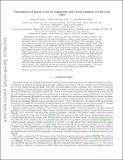Files in this item
Consequences of glacial cycles for magmatism and carbon transport at mid-ocean ridges
Item metadata
| dc.contributor.author | Cerpa, Nestor G. | |
| dc.contributor.author | Rees Jones, David W. | |
| dc.contributor.author | Katz, Richard F. | |
| dc.date.accessioned | 2020-09-25T23:36:04Z | |
| dc.date.available | 2020-09-25T23:36:04Z | |
| dc.date.issued | 2019-12-15 | |
| dc.identifier | 261388874 | |
| dc.identifier | a42d2911-9edd-4db0-a366-c74706dc0627 | |
| dc.identifier | 85072601945 | |
| dc.identifier | 000493223500009 | |
| dc.identifier.citation | Cerpa , N G , Rees Jones , D W & Katz , R F 2019 , ' Consequences of glacial cycles for magmatism and carbon transport at mid-ocean ridges ' , Earth and Planetary Science Letters , vol. 528 , 115845 . https://doi.org/10.1016/j.epsl.2019.115845 | en |
| dc.identifier.issn | 0012-821X | |
| dc.identifier.other | Bibtex: urn:d1b6f08463874fa082bd3603ce24d16f | |
| dc.identifier.other | ORCID: /0000-0001-8698-401X/work/62311915 | |
| dc.identifier.uri | https://hdl.handle.net/10023/20691 | |
| dc.description | This research received funding from the European Research Council under the European Union's Seventh Framework Programme (FP7/2007–2013)/ERC grant agreement number 279925 and under Horizon 2020 research and innovation programme grant agreement number 772255. N.G.C. acknowledges support from the University of Montpellier and public funding through ANR under the “Investissements d'avenir” programme with the reference ANR-16-IDEX-0006. D.R.J. acknowledges research funding through the NERC Consortium grant NE/M000427/1, NERC Standard grant NE/I026995/1 and the Leverhulme Trust. We thank the Isaac Newton Institute for Mathematical Sciences for its hospitality during the programme Melt in the Mantle that was supported by EPSRC Grant Number EP/K032208/1. We thank the Deep Carbon Observatory of the Sloan Foundation. | en |
| dc.description.abstract | Magmatism and volcanism transfer carbon from the solid Earth into the climate system. This transfer may be modulated by the glacial/interglacial cycling of water between oceans and continental ice sheets, which alters the surface loading of the solid Earth. The consequent volcanic-carbon fluctuations have been proposed as a pacing mechanism for Pleistocene glacial cycles. This mechanism is dependant on the amplitude and lag of the mid-ocean ridge response to sea-level changes. Here we develop and analyse a new model for that response, eliminating some questionable assumptions made in previous work. Our model calculates the carbon flux, accounting for the thermodynamic effect of mantle carbon: reduction of the solidus temperature and a deeper onset of melting. We analyse models forced by idealised, periodic sea level and conclude that fluctuations in melting rate are the prime control on magma and carbon flux. We also discuss a model forced by a reconstruction of eustatic sea level over the past 800 kyr. It indicates that peak-to-trough variations of magma and carbon flux are up to about 20% and 10% of the mean flux, respectively. Peaks in mid-ocean ridge emissions lag peaks in sea-level forcing by less than about 20 kyr and the lag could well be shorter. The amplitude and lag are sensitive to the rate of melt segregation. The lag is much shorter than the time it takes for melt to travel vertically across the melting region. | |
| dc.format.extent | 4662805 | |
| dc.language.iso | eng | |
| dc.relation.ispartof | Earth and Planetary Science Letters | en |
| dc.subject | Mid-ocean ridges | en |
| dc.subject | Glacial cycles | en |
| dc.subject | Magmatism | en |
| dc.subject | Carbon flux | en |
| dc.subject | GE Environmental Sciences | en |
| dc.subject | T-DAS | en |
| dc.subject | SDG 13 - Climate Action | en |
| dc.subject.lcc | GE | en |
| dc.title | Consequences of glacial cycles for magmatism and carbon transport at mid-ocean ridges | en |
| dc.type | Journal article | en |
| dc.contributor.institution | University of St Andrews. Applied Mathematics | en |
| dc.identifier.doi | 10.1016/j.epsl.2019.115845 | |
| dc.description.status | Peer reviewed | en |
| dc.date.embargoedUntil | 2020-09-26 | |
| dc.identifier.url | https://arxiv.org/abs/1904.03154 | en |
This item appears in the following Collection(s)
Items in the St Andrews Research Repository are protected by copyright, with all rights reserved, unless otherwise indicated.

